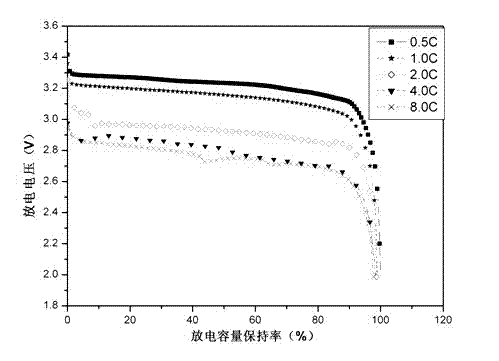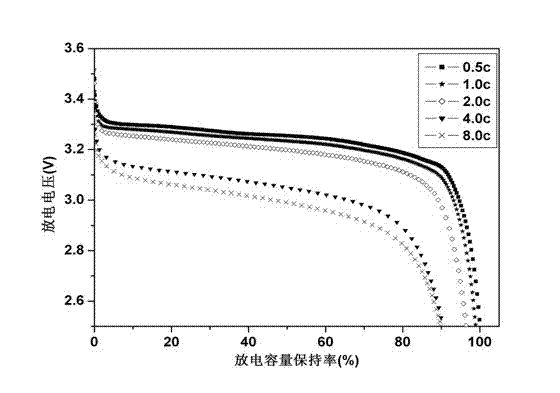Lithium ion battery negative pole material capable of improving safety performance and preparation method thereof
A lithium-ion battery and negative electrode material technology, applied in the field of electrochemistry, can solve the problems of limited battery safety performance, reduce the overall thermal runaway, reduce the probability of dendrites piercing the diaphragm, and prevent the battery from overheating.
- Summary
- Abstract
- Description
- Claims
- Application Information
AI Technical Summary
Problems solved by technology
Method used
Image
Examples
Embodiment 1
[0016] After the negative pole piece is rolled, the surface of the negative pole is coated with a layer of LiAlO by ultrasonic spraying 2 Film; the steps are as follows: 1) slurry configuration, weigh 100 grams of LiAlO 2 , 10 grams of LA132 adhesive, 2 grams of CMC adhesive, 1 gram of SP conductive agent, 640 grams of double distilled water, configured into a 15% concentration of lithium metaaluminate slurry; 2) coating: the above slurry Use the ultrasonic spray method (the equipment frequency is 500KHz) to coat the surface of the negative pole piece with lithium metaaluminate material, then bake it at 50℃ for 1 hour, and then dry it to obtain LiAlO with a thickness of 2μm. 2 Thin film negative pole piece. The chemical name of LA132 binder and CMC binder is sodium carboxymethyl cellulose, and the conductive agent is Super-P.
Embodiment 2
[0018] The production process of the lithium ion battery provided in this embodiment is the same as the production process commonly used in this field, except that: after the negative pole piece is rolled, a layer of LiAlO is coated on the surface of the negative electrode by ultrasonic spraying. 2 Film; 1) slurry configuration, weigh 100 grams of LiAlO 2 , 5 grams of LA132 adhesive, 2 grams of CMC adhesive, 1 gram of SP conductive agent, 2052 grams of double distilled water, configured into a 5% concentration of lithium metaaluminate slurry; 2) coating: the above slurry Ultrasonic spraying method (the equipment frequency is 1MHz) is used to coat the surface of the negative pole piece with lithium metaaluminate material, and then bake for 2 hours at a temperature of 40℃, and then dry to obtain a LiAlO with a thickness of 1μm on the surface. 2 Thin film negative pole piece.
Embodiment 3
[0020] After the negative pole piece is rolled, a layer of LiAlO2 film is coated on the surface of the negative electrode by ultrasonic spraying; the process is as follows: 1) slurry configuration, weigh 50 grams of LiAlO 2 , 10 grams of LA132 binder, 1 gram of CMC, 1 gram of SP conductive agent, 93 grams of double distilled water, configured into a 40% concentration of lithium metaaluminate slurry; 2) coating: the above slurry is ultrasonic sprayed Method (the device frequency is 1MHz) Coat the surface of the negative pole piece with lithium metaaluminate material, then bake it at a temperature of 80℃ for 2h, and dry it to finally obtain LiAlO with a surface coating thickness of 10μm 2 Thin film negative pole piece.
PUM
| Property | Measurement | Unit |
|---|---|---|
| thickness | aaaaa | aaaaa |
| size | aaaaa | aaaaa |
| size | aaaaa | aaaaa |
Abstract
Description
Claims
Application Information
 Login to View More
Login to View More - R&D
- Intellectual Property
- Life Sciences
- Materials
- Tech Scout
- Unparalleled Data Quality
- Higher Quality Content
- 60% Fewer Hallucinations
Browse by: Latest US Patents, China's latest patents, Technical Efficacy Thesaurus, Application Domain, Technology Topic, Popular Technical Reports.
© 2025 PatSnap. All rights reserved.Legal|Privacy policy|Modern Slavery Act Transparency Statement|Sitemap|About US| Contact US: help@patsnap.com


